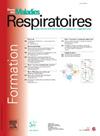肺纤维化与肺癌相关的蛋白质组学分析揭示了凋亡通路的失调
IF 0.5
4区 医学
Q4 RESPIRATORY SYSTEM
引用次数: 0
摘要
肺纤维化(PF),尤其是特发性肺纤维化,与肺癌(LC)的高风险相关,但其致癌机制尚不清楚。结合液相色谱-质谱(LC-MS/MS)和质谱成像(MSI),我们比较了有和没有LC的PF组织样品的纤维化区域的蛋白质组,以确定改变的信号通路。方法选取有LC (LC+, n = 17)和无LC (LC -, n = 17) PF患者的34例福尔马林固定石蜡包埋(FFPE)手术标本。对于每种情况,选择一个具有代表性的FFPE块进行下游分析。对纤维化区进行宏观解剖后,采用LC-MS/MS分析全蛋白提取物。在胰蛋白酶消化后的组织切片上进行MSI,在纤维化区域内选择感兴趣的区域。在硅胰蛋白酶消化感兴趣的肽进一步进行,并在离子图上可视化这些肽的空间定位。结果通过LC-MS/MS分析,我们鉴定出4901个蛋白中有72个在LC-和LC+样品的纤维化区域中表达显著差异(P <;0.001)。通路分析提示氧化应激代谢与细胞凋亡有关,在LC附近的纤维化区域,两种已知激活细胞凋亡的线粒体蛋白(BAX, Frataxin)显著下调。在对BAX蛋白进行硅胰蛋白酶消化后,MSI分析显示每个蛋白至少有2个独特的肽在LC+纤维化区域显著低表达。互补离子图谱分析显示,这些线粒体肽在连接蜂窝囊肿的化生上皮细胞中特异性表达。通过结合LC-MS/MS和MSI的原始蛋白质组学方法,我们发现,在PF患者中,纤维化区域具有不同的蛋白质组学特征,这取决于LC的存在。LC附近的纤维化区表现出促凋亡线粒体蛋白的显著下调。有趣的是,MSI的空间分析显示,这些蛋白在纤维化区域的化生上皮细胞中表达,这表明这些细胞凋亡的失调可能参与了PF患者的肺癌发生。本文章由计算机程序翻译,如有差异,请以英文原文为准。
Proteomic analysis of pulmonary fibrosis associated with lung cancer reveals dysregulation of the apoptotic pathway
Introduction
Pulmonary fibrosis (PF), especially idiopathic pulmonary fibrosis, is associated with a high risk of lung cancer (LC), but the mechanisms of carcinogenesis remains poorly understood. Combining Liquid Chromatography Mass Spectrometry (LC-MS/MS) and Mass Spectrometry Imaging (MSI), we compared the proteome of fibrotic areas from PF tissue samples with and without LC to identify altered signaling pathways.
Methods
34 Formalin Fixed Paraffin-Embedded (FFPE) surgical samples from patients with PF with LC (LC+, n = 17) and without LC (LC−, n = 17) were included. For each case, a representative FFPE block was selected for downstream analyses. After macrodissection of fibrotic areas, whole protein extracts were analyzed by LC-MS/MS. MSI was performed on tissue section after tryptic digestion, on selected regions of interest within fibrotic areas. In silico tryptic digestion of peptides of interest was further performed, and spatial localization of these peptides was visualized on ion maps.
Results
By LC-MS/MS analysis, we identified 72 out of 4901 proteins significantly differentially expressed between fibrotic areas of LC- and LC+ samples (P < 0.001). Pathway analysis suggested the involvement of oxidative stress metabolism and apoptosis, with significant downregulation of two mitochondrial proteins (BAX, Frataxin), known to activate apoptosis, in fibrotic areas adjacent to LC. After in silico tryptic digestion of BAX protein, MSI analysis revealed at least 2 unique peptides per protein that were significantly underexpressed in LC+ fibrotic areas. Complementary ion map analysis showed a specific expression of these mitochondrial peptides within metaplastic epithelial cells ligning honeycomb cysts.
Conclusion
Using an original proteomic approach integrating LC-MS/MS and MSI, we show that, in patients with PF, fibrotic areas have distinct proteomic profiles depending on the presence of LC. Fibrotic areas adjacent to LC exhibit a significant downregulation of pro-apoptotic mitochondrial proteins. Interestingly, spatial analysis by MSI show that these proteins are expressed by metaplastic epithelial cells within fibrotic areas, suggesting that dysregulation of apoptosis in these cells might be involved in lung carcinogenesis in patients with PF.
求助全文
通过发布文献求助,成功后即可免费获取论文全文。
去求助
来源期刊

Revue des maladies respiratoires
医学-呼吸系统
CiteScore
1.10
自引率
16.70%
发文量
168
审稿时长
4-8 weeks
期刊介绍:
La Revue des Maladies Respiratoires est l''organe officiel d''expression scientifique de la Société de Pneumologie de Langue Française (SPLF). Il s''agit d''un média professionnel francophone, à vocation internationale et accessible ici.
La Revue des Maladies Respiratoires est un outil de formation professionnelle post-universitaire pour l''ensemble de la communauté pneumologique francophone. Elle publie sur son site différentes variétés d''articles scientifiques concernant la Pneumologie :
- Editoriaux,
- Articles originaux,
- Revues générales,
- Articles de synthèses,
- Recommandations d''experts et textes de consensus,
- Séries thématiques,
- Cas cliniques,
- Articles « images et diagnostics »,
- Fiches techniques,
- Lettres à la rédaction.
 求助内容:
求助内容: 应助结果提醒方式:
应助结果提醒方式:


